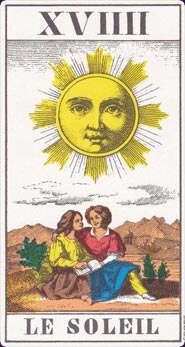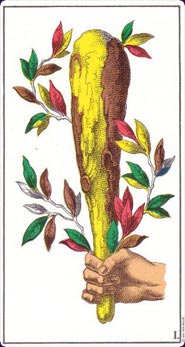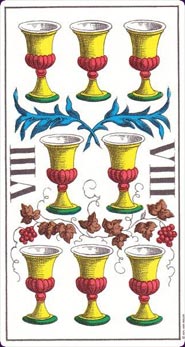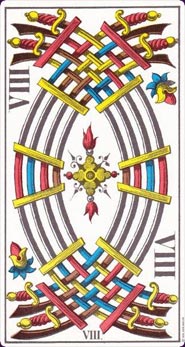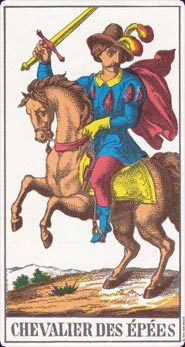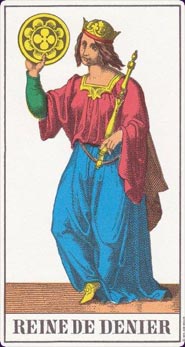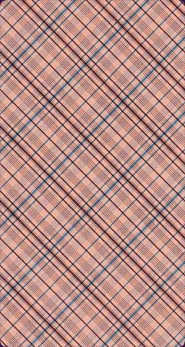1JJ Swiss Tarot Deck Review
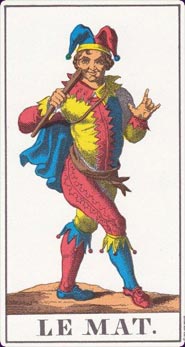
The 1JJ Swiss Tarot is an older style of tarot deck, a Marseilles variant. The cards are reprints of early woodcut designs, printed in black and coloured with blocks of red, blue, green and yellow. Titles are in French.
Deck Type: Tarot Deck Cards: 78
Creators: Stuart Kaplan
Publisher: AGM-Urania 1970
Retailers
See Price at Amazon.comSee Price at Amazon.co.uk
1JJ Swiss Tarot Review by Steve Gustafson
This was my first Tarot deck. It was not my last. Early on, I became somewhat uncomfortable with it, because of things I was reading. I bought it at a Spencer Gifts or some such purveyor of enlightenment. This would have been in 1975 or so. I would have been around fifteen.
First, most of the books assumed that you owned a Rider-Waite-Smith deck. I found it less than adequate because the RWS deck had all the extra pictures and mystic symbols and this one did not. Then I checked out some library book that said that the Marseille cards had all of this arcane lore connected to the colours and shapes of the original Marseille. And this isn't one of them, either.
But I stuck with it, learning to read it by studying the RWS images in the book and calling them to mind with the pip cards of this deck. This perhaps was not the easy way, but I stuck with it. And later, when I (moved beyond)/(rebelled against) some of the imagery of the RWS scenes, the 1JJ was accomodating, but the RWS scenes are much harder to ignore. You try telling somebody that the RWS Ten of Swords might just mean a looming bar exam.
This would be a "Soprafino" Tarot if it were Italian. The images are finely detailed coloured engravings. But it's a Soprafino that has remained in production to the present day, so what you get are new printings rather than faded reproductions. This will be to some people's tastes, but not everyone's. The colours will be much louder than a reproduction deck.
The deck is a Marseille variant. The most obvious difference between the Marseille and the 1JJ is that Juno and her peacock, and Jupiter and his eagle have been swapped in for the Papess and the Pope. This continues a tradition that began in the Tarot de Besancon. The decks were apparently sold throughout an area that contained both zealous Catholics and zealous Protestants, who didn't want a Pope or a Papess for rather different reasons.
It seems that many current Taroteurs don't want a Papess or Pope either, for reasons of their own. Using the Roman gods gets around them in an insightful way that keeping the old images but renaming these trumps to "The High Priestess" or "The Hierophant" doesn't. It also works better than some other substitutions that have been made in historical decks. In "The Magical World of the Tarot," Gareth Knight praises this substitution as appropriate and insightful.
There are other merits to the Trumps of this deck. Dame Fortuna has been restored to her role as the turner of the Wheel of Fortune, and the figures rising and falling have recovered their humanity as well. The Death card is one of the best Deaths of any deck I know of, traditional, esoteric, or modern: the usual image of the reaping skeleton, but drawn well, unlike the crude skeleton of the original Marseilles.
There are other less successful innovations that have been made here, though. Two of the sacred animals have gone missing from the World. The Fool is a particular failure here; he's been turned into a standard court jester in motley, and has lost his dog, his backpack, and his setting.
My 1JJ is in French. Get the French version if you can find it: this is the original. An English version exists, but in it the Deniers have been made into Pentacles, and the Batons into Wands; this strikes me as anachronistic on a traditional deck.
Used to be that the 1JJ
was one of the easiest to find Tarots. There are many
more on the market now, and you'd probably have to look
for this one a bit harder now. If you attach special
significance to the presence of every Marseille symbol, it will
not get the job done. But if you are comfortable
reading a pip card deck, this deck has both nineteenth
century and twentieth century tradition on its side.
1JJ Swiss Tarot Review by Bonnie Cehovet
This deck came to me in a very magickal manner. A friend of my sisters mentioned that she had been gifted with the deck from her brother. I had always wanted to see the deck, and had never had an opportunity to do so. I asked my sister to ask Lori (her friend) to bring the deck with her when she came to visit, as I was going to be there also, to gather some holly for Christmas decorating. Lori gifted me with the deck - saying that she felt that it was time to let it find a new home, that she had other things from her brother that meant more to her. I was humbled and quite eccstatic! I immediately placed it with the decks that I draw a card a day from. It has a very happy home right by my computer.
The IJJ Swiss is a reproduction of a 19th century Tarot deck, somewhat in the Marseilles tradition. The "J's" stand for Jupiter and Junon, Roman equivelants for the Greek Gods Zeus and Hera. They were substituted in this deck for the Pope and Popess, in an effort not to affront the Catholic Church.
The IJJ's one claim to fame is that it was the first Tarot deck presented by U.S. Games. The LWB that came with the deck in minimalist, to say the least. The court cards are named but not discussed, the suits are named but not discussed, the major arcana are named and minimally defined (the cards themselves are in French). The spread presented is the traditional Celtic Cross.
The pips do not show people or scenes, they show just the symbol for the suit. Some readers may find this difficult - I am very attracted to the deck, and do not find this to be a block of any kind. What I do find difficult is that the cards are labled in French - but it is not difficult ot determine which card is which.
The numbering is in Roman numerals, but very different than I have seen before. Temperance (14) is written as XIIII, rather than XIV. Le Soleil (19) is written as XVIIII, rather than XIX. L'Ermite (9) is written as VIIII, rather than IX. The nine of Coupes is written as VIIII, while the other suits are written as IX. L'Empereur is written as IIII, as is the four of Coupes and Deniers. The four of Batons and Eppes are written as IV.
The pictures are done in a very fine line style, colored in with red, gold blue and brown. The major arcana are depicted as very close to the traditional portrayal.
The cards are smaller than a regular size deck - very easy to handle for smaller hands. Even without pictures on the pips, the deck reads easily. This deck could be used without a problem by someone just learning the Tarot or by someone who has been reading for a long time.
Complete Details of 1JJ Swiss Tarot
Creators: Stuart KaplanPublisher: AGM-Urania 1970
Deck Type: Tarot Deck
Cards: 78
Major Arcana: 22
Minor Arcana: 56
Deck Tradition: Marseilles
Minor Arcana Style: Marseilles-Style Pips
Suits: Coupes, Deniers, Epees, Batons
Court Cards: Roi, Reine, Chevalier, Valet
The Fool is 0
Strength is 11
Justice is 8
Card Size: 2.37 x 4.37 in. = 6.03cm x 11.11cm
Card Language: French
Card Back: Reversible
Back Design: Ruddy-coloured check pattern.
Companion Material: The separate companion book written by Stuart R. Kaplan has been published a few times. First in 1970 as Tarot cards for Fun and Fortune Telling by US Games. Then it was first published in the UK by the Aquarian Press as Tarot Cards for Fun and Fortune Telling in 1978. The next edition was published in 1995 by Diamond Books and is called Fortune Telling with Tarot Cards.
Rating: 12/20 or
Similar Decks to 1JJ Swiss Tarot
Theme: MarseillesCreator: Blue Bird Lenormand, Tarot Classic by Stuart Kaplan
Home > Tarot Reviews > 1JJ Swiss Tarot Review

